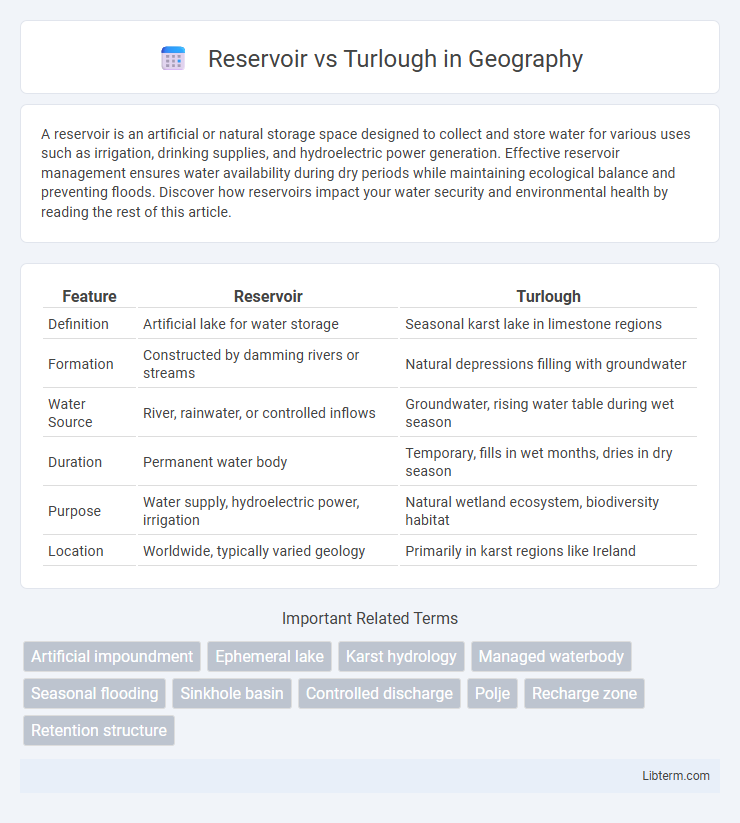A reservoir is an artificial or natural storage space designed to collect and store water for various uses such as irrigation, drinking supplies, and hydroelectric power generation. Effective reservoir management ensures water availability during dry periods while maintaining ecological balance and preventing floods. Discover how reservoirs impact your water security and environmental health by reading the rest of this article.
Table of Comparison
| Feature | Reservoir | Turlough |
|---|---|---|
| Definition | Artificial lake for water storage | Seasonal karst lake in limestone regions |
| Formation | Constructed by damming rivers or streams | Natural depressions filling with groundwater |
| Water Source | River, rainwater, or controlled inflows | Groundwater, rising water table during wet season |
| Duration | Permanent water body | Temporary, fills in wet months, dries in dry season |
| Purpose | Water supply, hydroelectric power, irrigation | Natural wetland ecosystem, biodiversity habitat |
| Location | Worldwide, typically varied geology | Primarily in karst regions like Ireland |
Introduction to Reservoirs and Turloughs
Reservoirs are artificial lakes or large storage ponds created by constructing dams across rivers to store water for purposes like irrigation, drinking, and hydroelectric power generation. Turloughs are seasonal, ephemeral lakes found mainly in karst landscapes, characterized by their periodic flooding and draining due to underground limestone drainage systems. While reservoirs are engineered for water management, turloughs are natural features influenced by geological and hydrological conditions.
Definitions: What is a Reservoir?
A reservoir is an artificial or natural lake used for storing water, typically created by constructing a dam across a river or stream to regulate water supply for irrigation, drinking, flood control, or hydroelectric power generation. It serves as a controlled water body designed to manage water resources efficiently. In contrast, a turlough is a seasonal, ephemeral lake usually found in karst limestone regions, filling with water during wet periods and drying out in drier seasons.
Definitions: What is a Turlough?
A turlough is a seasonal lake found primarily in limestone regions of Ireland, characterized by its intermittent flooding and draining patterns due to underground karstic drainage. Unlike reservoirs, which are artificially created water storage structures designed for consistent water retention and management, turloughs appear naturally and fluctuate with groundwater levels. The ephemeral nature of turloughs supports unique ecosystems adapted to periodic wet and dry conditions, contrasting with the permanent water bodies of reservoirs.
Natural Formation of Turloughs
Turloughs are seasonal lakes typically found in karst limestone regions of Ireland, formed naturally by the interaction between groundwater and surface drainage through underground caverns and swallow holes. Unlike reservoirs, which are artificial water storage structures created by damming rivers or streams, turloughs fill and drain depending on the water table level and precipitation patterns. Their natural formation relies on the unique geological features of limestone landscapes, allowing water to accumulate temporarily in depressions during wet seasons.
Engineering and Construction of Reservoirs
Reservoir engineering involves designing large-scale dams and storage basins to control water flow, ensuring structural stability and efficient capacity management using materials like concrete and earthfill. Construction of reservoirs requires geological surveys, hydrological analysis, and implementation of spillways, sluice gates, and impermeable liners to prevent seepage and manage overflow. Unlike natural turloughs, which are seasonal karst depressions flooded by groundwater, reservoirs are purpose-built infrastructures engineered for water supply, flood control, and irrigation.
Key Differences Between Reservoirs and Turloughs
Reservoirs are artificial lakes created by damming rivers to store water for purposes like irrigation, hydroelectric power, and drinking water supply, while turloughs are seasonal karst depressions found primarily in limestone regions that fill with water during wet seasons and dry out in summer. Reservoirs have controlled water levels maintained by man-made structures, whereas turlough water levels fluctuate naturally based on groundwater and rainfall patterns without human intervention. The primary distinction lies in reservoirs being engineered water bodies with permanent infrastructure, whereas turloughs are natural, ephemeral wetlands influenced by geological and climatic conditions.
Ecological Significance of Turloughs
Turloughs, seasonal karstic lakes found primarily in Ireland, play a critical ecological role by providing unique wetland habitats that support specialized flora and fauna adapted to fluctuating water levels. Unlike reservoirs, which are artificial and maintain consistent water levels for human use, turloughs undergo periodic flooding and drying, creating dynamic environments essential for amphibians, migratory birds, and rare plant species. The ecological significance of turloughs lies in their contribution to biodiversity conservation, nutrient cycling, and maintaining hydrological balance in limestone karst landscapes.
Human Uses and Benefits of Reservoirs
Reservoirs provide crucial water storage for irrigation, drinking water, and hydroelectric power generation, supporting agriculture and urban needs year-round. They enable effective flood control and drought management, ensuring stable water supply during variable climatic conditions. Unlike turloughs, which are seasonal and less controllable, reservoirs offer consistent benefits for human consumption, industry, and environmental regulation.
Environmental Impacts: Reservoirs vs Turloughs
Reservoirs significantly alter natural water flow and disrupt local ecosystems by submerging large land areas, reducing biodiversity, and affecting water quality through sediment accumulation and temperature changes. Turloughs, seasonal limestone wetlands common in karst regions, support unique habitats adapted to periodic flooding and drying, contributing to high biodiversity and natural groundwater recharge without the extensive landscape alteration seen in reservoirs. The environmental impacts of reservoirs are generally more severe due to habitat loss and hydrological changes, whereas turloughs maintain ecological balance by preserving dynamic wetland functions.
Conclusion: Choosing Between Reservoir and Turlough
Choosing between a reservoir and a turlough depends on water management goals and environmental impact considerations. Reservoirs provide controlled water storage for supply, irrigation, and flood control, but may disrupt natural ecosystems. Turloughs, seasonal karst lakes found in limestone regions, offer unique habitats and groundwater recharge benefits but have limited water storage capacity and predictability.
Reservoir Infographic

 libterm.com
libterm.com